Effect of Sampietrini Pavers on Urban Heat Islands
Abstract
:1. Introduction
- Reflective pavements. Their high albedo value contributes to reducing the surface temperature. An increase in the albedo value can be obtained by modifying two critical parameters: the color and the roughness of the pavement. Making the surface lighter or smoother decreases the amount of heat that it absorbs and instead increases the amount of reflected heat. Thus, high reflectance light paints and lighter building materials (e.g., clear concrete and stone materials) could lower surface temperatures in urban areas [26]. This complies with the approach taken by the Italian Ministry of the Environment [27] that requires “cool” pavements (e.g., white stones, permeable concrete blocks, paving grids for grass parking lots) to prevent UHI.
- Porous pavements. These have higher porosity than conventional pavements. The voids allow the entry of floods into the pavements and water infiltrated below the pavement evaporates while the surface heats up. The obtained evaporative cooling of the pavements counters the heat island effect. The performance of a permeable pavement can be assessed considering three criteria: the ability to reduce the surface temperature by evaporation, the ability to reduce the risk of flooding, and pavement durability [26].
- pebble pavements are composed of river stone elements,
- flagstone pavements are composed of parallelepiped blocks of stone, in which the plant dimensions are higher than the width of the elements,
- cobblestone pavements are composed of parallelepipeds, in which the three dimensions have comparable magnitudes.
2. Materials and Methods
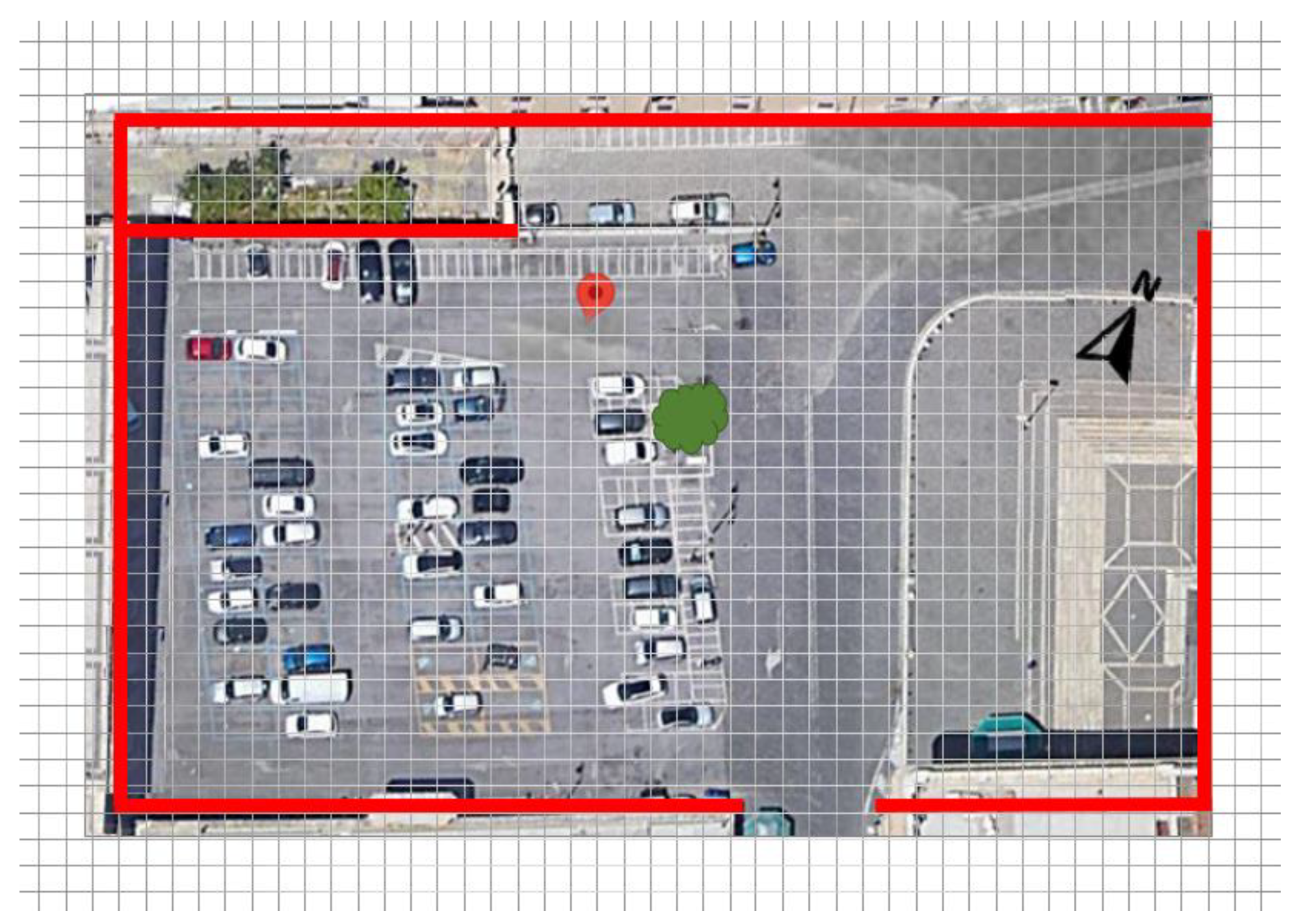
| Material | Albedo | Emissivity | Color in Figure 11, Figure 12 and Figure 13 |
|---|---|---|---|
| Asphalt | 0.20 | 0.90 | |
| Sampietrini (traditional pattern) | 0.40 | 0.90 | |
| Sampietrini (permeable pattern) | 0.40 | 0.92 |
- first scenario (S1): the current layout, where asphalt and sampietrini compose the square pavement (black and dark gray areas in Figure 11, respectively).
- second scenario (S2): traditional sampietrini pavement substitutes asphalt surface and covers all the square (Figure 12).
- third scenario (S3): permeable sampietrini pavement substitutes asphalt surface in the square (white area in Figure 13).
- air temperature (AT) in the examined square, and
- predicted mean vote (PMV) (i.e., a human comfort index that summarizes the impact of six parameters: air temperature, mean radiant temperature, wind speed, moisture, clothing and activity level) [42]. The PMV ranges between +/−3, according to the scale in Figure 14.The range +/−1 is the so-called comfort zone and represents the ideal condition. It must be emphasized that applying the PMV equation to outdoor conditions in summer heat stress situations can easily produce high PMV values above +3 (+5 and more).
3. Results
4. Discussion
5. Conclusions
Author Contributions
Funding
Institutional Review Board Statement
Informed Consent Statement
Data Availability Statement
Acknowledgments
Conflicts of Interest
References
- Alvarez, I.; Quesada-Ganuza, L.; Briz, E.; Garmendia, L. Urban heat islands and thermal comfort: A case study of Zorrotzaurre island in Bilbao. Sustainability 2021, 13, 6106. [Google Scholar] [CrossRef]
- Paltsev, S.; Monier, E.; Scott, J.; Sokolov, A.; Reilly, J. Integrated economic and climate projections for impact assessment. Clim. Chang. 2015, 131, 21–33. [Google Scholar] [CrossRef] [Green Version]
- Agrawal, I.N.; Pandey, V.K.; Mishra, S.K.; Pandey, V.S.; Agrawal, N.; Banerjee, K. Modeling seasonal trends in optimum temperatures over India. J. Water Clim. Chang. 2021, 12, 1420–1436. [Google Scholar] [CrossRef]
- Faroughi, M.; Karimimoshaver, M.; Aram, F.; Solgi, E.; Mosavi, A.; Nabipour, N.; Chau, K.W. Computational modeling of land surface temperature using remote sensing data to investigate the spatial arrangement of buildings and energy consumption relationship. Eng. Appl. Comput. Fluid Mech. 2020, 14, 254–270. [Google Scholar] [CrossRef]
- Mohajerani, A.; Bakaric, J.; Jeffrey-Bailey, T. The urban heat island effect, its causes, and mitigation, with reference to the thermal properties of asphalt concrete. J. Environ. Manag. 2017, 197, 522–538. [Google Scholar] [CrossRef] [PubMed]
- Intergovernmental Panel on Climate Change. Climate Change 2014: Synthesis Report; Core Writing Team, Pachauri, R.K., Meyer, L.A., Eds.; Contribution of Working Groups I, II and III to the Fifth Assessment Report of the Intergovernmental Panel on Climate Change; IPCC: Geneva, Switzerland, 2014. [Google Scholar]
- Akbari, H.; Kolokotsa, D. Three decades of urban heat islands and mitigation technologies research. Energy Build. 2016, 133, 834–852. [Google Scholar] [CrossRef]
- Norton, B.A.; Coutts, A.M.; Livesley, S.J.; Harris, R.J.; Hunter, A.M.; Williams, N.S.G. Planning for cooler cities: A framework to prioritise green infrastructure to mitigate high temperatures in urban landscapes. Landsc. Urban Plan. 2015, 134, 127–138. [Google Scholar] [CrossRef]
- Santamouris, M. Using cool pavements as a mitigation strategy to fight urban heat island-A review of the actual developments. Renew. Sustain. Energy Rev. 2013, 26, 224–240. [Google Scholar] [CrossRef]
- Pomerantz, M.; Pon, B.; Akbari, H.; Chang, S.-C. The Effect of Pavements’ Temperatures on Air Temperatures in Large Cities; LBNL-43442; Lawrence Berkeley National Laboratory: Berkeley, CA, USA, 2000. [Google Scholar]
- Vujovic, S.; Haddad, B.; Karaky, H.; Sebaibi, N.; Boutouil, M. Urban Heat Island: Causes, Consequences, and Mitigation Measures with Emphasis on Reflective and Permeable Pavements. CivilEng 2021, 2, 459–484. [Google Scholar] [CrossRef]
- Santamouri, M.; Asimakopoulos, D.N.; Assimakopoulos, V.D.; Chrisomallidou, N.; Klitsikas, N.; Mangold, D.; Michel, P.; Santamouris, M.; Tsangrassoulis, A. Energy and Climate in the Urban Built Environment; Routledge: London, UK, 2013; pp. 1–402. [Google Scholar] [CrossRef]
- Wong, E. Reducing urban heat islands: Compendium of strategies—Urban heat island basics. In The Climate Protection Partnership Division; Environmental Protection Agency’s Office of Atmospheric Programs: Washington, DC, USA, 2014. [Google Scholar]
- Killingsworth, B.; Lemay, L.; Peng, T. Concrete’s Role in Reducing Urban Heat Islands; Concrete Sustainability Report; NRMCA CSR: Alexandria, VA, USA, 2014. [Google Scholar]
- MacLachlan, A.; Biggs, E.; Roberts, G.; Boruff, B. Urbanisation-Induced Land Cover Temperature Dynamics for Sustainable Future Urban Heat Island Mitigation. Urban Sci. 2017, 1, 38. [Google Scholar] [CrossRef] [Green Version]
- Akpınar, M.V.; Sevin, S. Reducing Urban Heat Islands by Developing Cool Pavements. In The Role of Exergy in Energy and the Environment; Nižetić, S., Papadopoulos, A., Eds.; Green Energy and Technology; Springer: Cham, Switzerland, 2018. [Google Scholar] [CrossRef]
- Akbari, H.; Rose, L.S. Urban Surfaces and Heat Island Mitigation Potentials. J. Hum.-Environ. Syst. 2008, 11, 85–101. [Google Scholar] [CrossRef] [Green Version]
- Ibrahim, S.H.; Ibrahim, N.I.A.; Wahid, J.; Goh, N.A.; Koesmeri, D.R.A.; Nawi, M.N.M. The impact of road pavement on urban heat island (UHI) phenomenon. Int. J. Technol. 2018, 9, 1597–1608. [Google Scholar] [CrossRef] [Green Version]
- Coseo, P.; Larsen, L. Cooling the Heat Island in Compact Urban Environments: The Effectiveness of Chicago’s Green Alley Program. Procedia Eng. 2015, 118, 691–710. [Google Scholar] [CrossRef] [Green Version]
- Costanzo, V.; Evola, G.M. Energy savings in buildings or UHI mitigation? Comparison between green roofs and cool roofs. Energy Build. 2016, 114, 247–255. [Google Scholar] [CrossRef]
- Noro, M.; Lazzarin, R. Urban heat island in Padua, Italy: Simulation analysis and mitigation strategies. Urban Clim. 2015, 14, 187–196. [Google Scholar] [CrossRef]
- Wayne Lee, K.; Kohm, S. Cool Pavements as Sustainable Approaches for Green Streets and Highways. Green Energy Technol. 2014, 204, 439–453. [Google Scholar] [CrossRef]
- Akbari, H.; Matthews, H.D. Global cooling updates: Reflective roofs and pavements. Energy Build. 2012, 55, 2–6. [Google Scholar] [CrossRef]
- Sankar Cheela, V.R.; John, M.; Biswas, W.; Sarker, P. Combating urban heat island effect—A review of reflective pavements and tree shading strategies. Buildings 2021, 11, 93. [Google Scholar] [CrossRef]
- Croce, S.; D’Agnolo, E.; Caini, M.; Paparella, R. The use of cool pavements for the regeneration of industrial districts. Sustainability 2021, 13, 6322. [Google Scholar] [CrossRef]
- Moretti, L.; Loprencipe, G. Climate Change and Transport Infrastructures: State of the Art. Sustainability 2018, 10, 4098. [Google Scholar] [CrossRef] [Green Version]
- Italian Ministry of the Environment. Adozione dei Criteri Ambientali Minimi per l’Affidamento di Servizi di Progettazione e Lavori per la Nuova Costruzione, Ristrutturazione e Manutenzione di Edifi ci per la Gestione dei Cantieri della Pubblica Amministrazione e Criteri Ambientali Minimi per le Forniture di Ausili per l’Incontinenza; Italian Ministry of the Environment: Rome, Italy, 2015.
- Di Mascio, P.; Moretti, L.; Capannolo, A. Concrete block pavements in urban and local roads: Analysis of stress-strain condition and proposal for a catalogue. J. Traffic Transp. Eng. 2019, 6, 557–566. [Google Scholar] [CrossRef]
- Zoccali, P.; Moretti, L.; Di Mascio, P.; Loprencipe, G.; D’Andrea, A.; Bonin, G.; Teltayev, B.; Caro, S. Analysis of natural stone block pavements in urban shared areas. Case Stud. Constr. Mater. 2018, 8, 498–506. [Google Scholar] [CrossRef]
- ENVI-met. Available online: https://www.envi-met.com/ (accessed on 4 September 2021).
- Kusumastuty, K.D.; Poerbo, H.W.; Koerniawan, M.D. Climate-sensitive urban design through Envi-Met simulation: Case study in Kemayoran, Jakarta. IOP Conf. Ser. Earth Environ. Sci. 2018, 129, 012036. [Google Scholar] [CrossRef]
- Wijeyesekera, D.; Mohamad Nazari, N.A.; Lim, S.; Masirin, M.; Zainorabidin, A.; Walsh, J. Investigation Into the Urban Heat Island Effects From Asphalt Pavements. OIDA Int. J. Sustain. Dev. 2012, 5, 97–118. [Google Scholar]
- Fiumi, L.; Georgiadis, T. Integrazioni di tecniche per la caratterizzazione termica delle pavimentazioni stradali in ambito urbano. In Proceedings of the Atti 12 a Conferenza Nazionale ASITA, L’Aquila, Italy, 21–24 Ottobre 2008; Available online: http://atti.asita.it/Asita2008/Pdf/233.pdf (accessed on 20 November 2021).
- Progettare IL Comfort Degli Spazi Pubblici Rebus® 08. Available online: https://territorio.regione.emilia-romagna.it/paesaggio/formazione-lab-app-1/rebus08-progettare-comfort-spazi-pubblici-valentina-dessi (accessed on 20 November 2021).
- Zoccali, P.; Loprencipe, G.; Galoni, A. Sampietrini stone pavements: Distress analysis using pavement condition index method. Appl. Sci. 2017, 7, 669. [Google Scholar] [CrossRef] [Green Version]
- Cantisani, G.; Fascinelli, G.; Loprencipe, G. Urban road noise: The contribution of pavement discontinuities. In Icsdec 2012: Developing the Frontier of Sustainable Design, Engineering, and Construction; Elsevier: Amsterdam, The Netherlands, 2013; pp. 327–334. [Google Scholar]
- UNI (Ente Italiano di Normazione). UNI 11714-1:2018. Rivestimenti Lapidei di Superfici Orizzontali, Verticali e Soffitti-Parte 1: Istruzioni per la Progettazione, la Posa e la Manutenzione; UNI: Milano, Italy, 2018. [Google Scholar]
- Tsoka, S.; Tsikaloudaki, A.; Theodosiou, T. Analyzing the ENVI-met microclimate model’s performance and assessing cool materials and urban vegetation applications–A review. Sustain. Cities Soc. 2018, 43, 55–76. [Google Scholar] [CrossRef]
- Moretti, L.; Di Mascio, P.; Fusco, C. Porous Concrete for Pedestrian Pavements. Water 2019, 11, 2105. [Google Scholar] [CrossRef] [Green Version]
- Maddu, R.; Vanga, A.R.; Sajja, J.K.; Basha, G.; Shaik, R. Prediction of land surface temperature of major coastal cities of India using bidirectional LSTM neural networks. J. Water Clim. Chang. 2021. [Google Scholar] [CrossRef]
- Di Mascio, P.; Fusco, G.; Grappasonni, G.; Moretti, L.; Ragnoli, A. Geometrical and Functional Criteria as a Methodological Approach to Implement a New Cycle Path in an Existing Urban Road Network: A Case Study in Rome. Sustainability 2018, 10, 2951. [Google Scholar] [CrossRef] [Green Version]
- Fanger, P.O. Thermal Comfort: Analysis and Applications in Environmental Engineering; R.E. Krieger Publishing Company: Malabar, FL, USA, 1982. [Google Scholar]





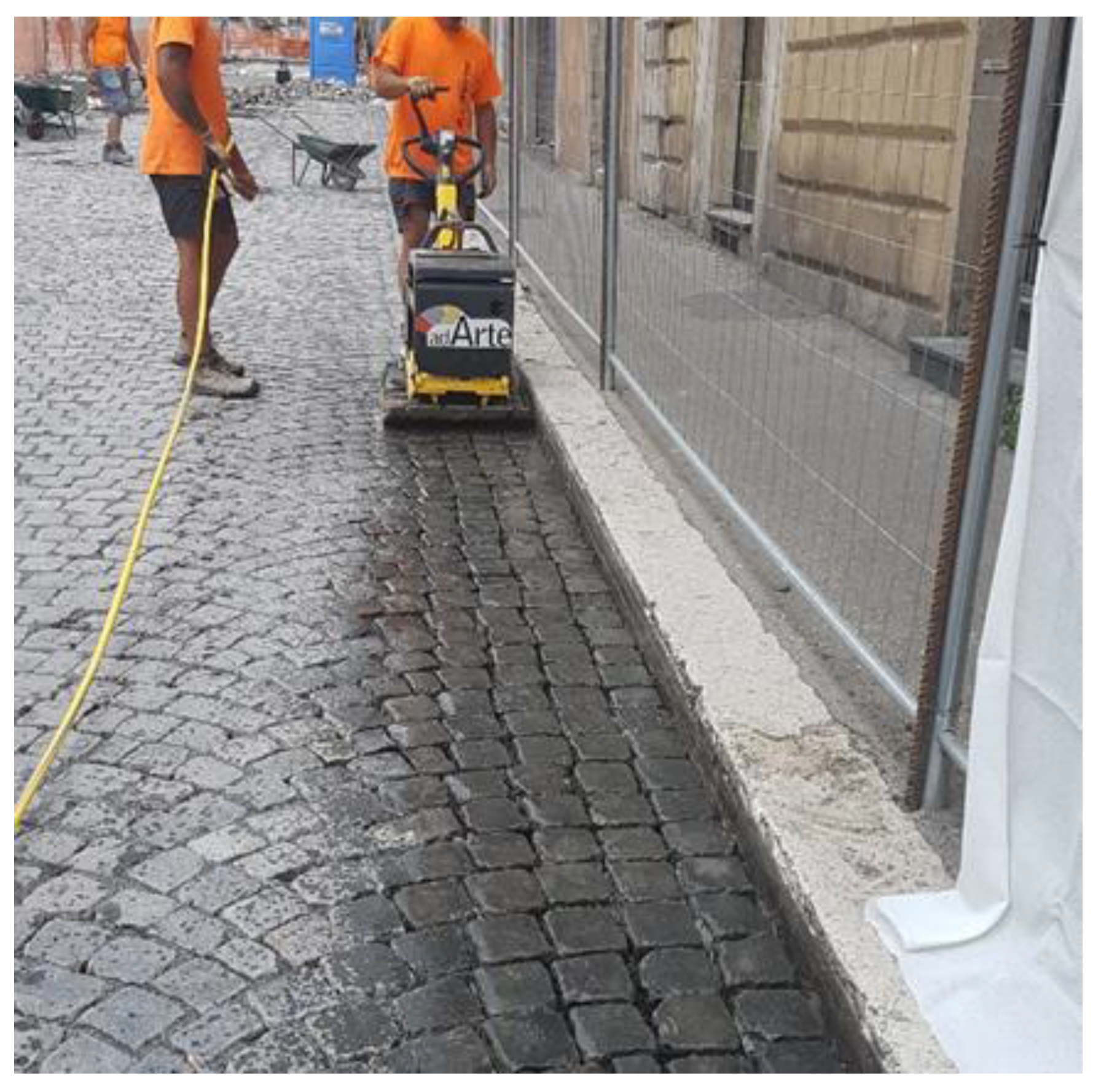
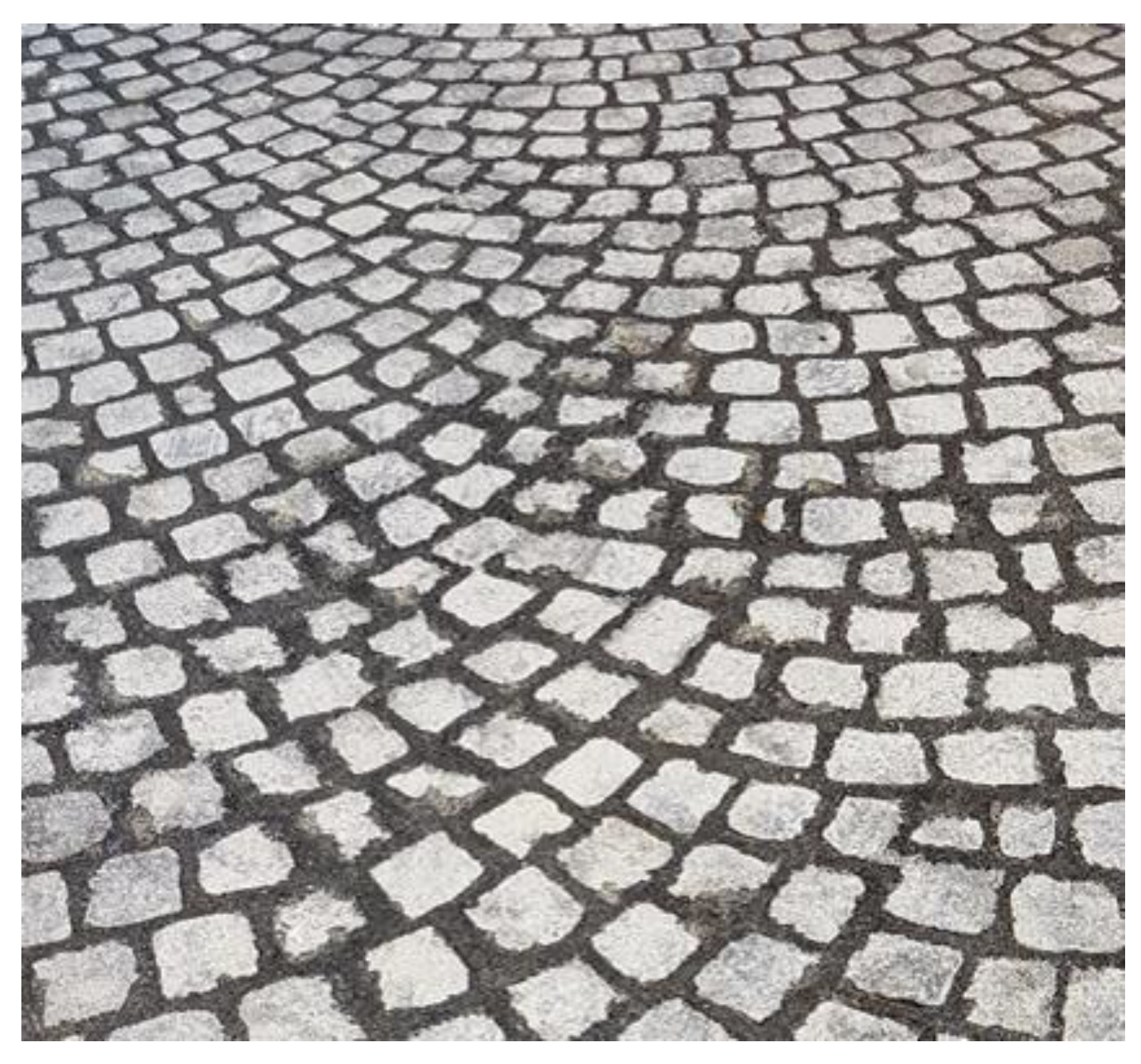



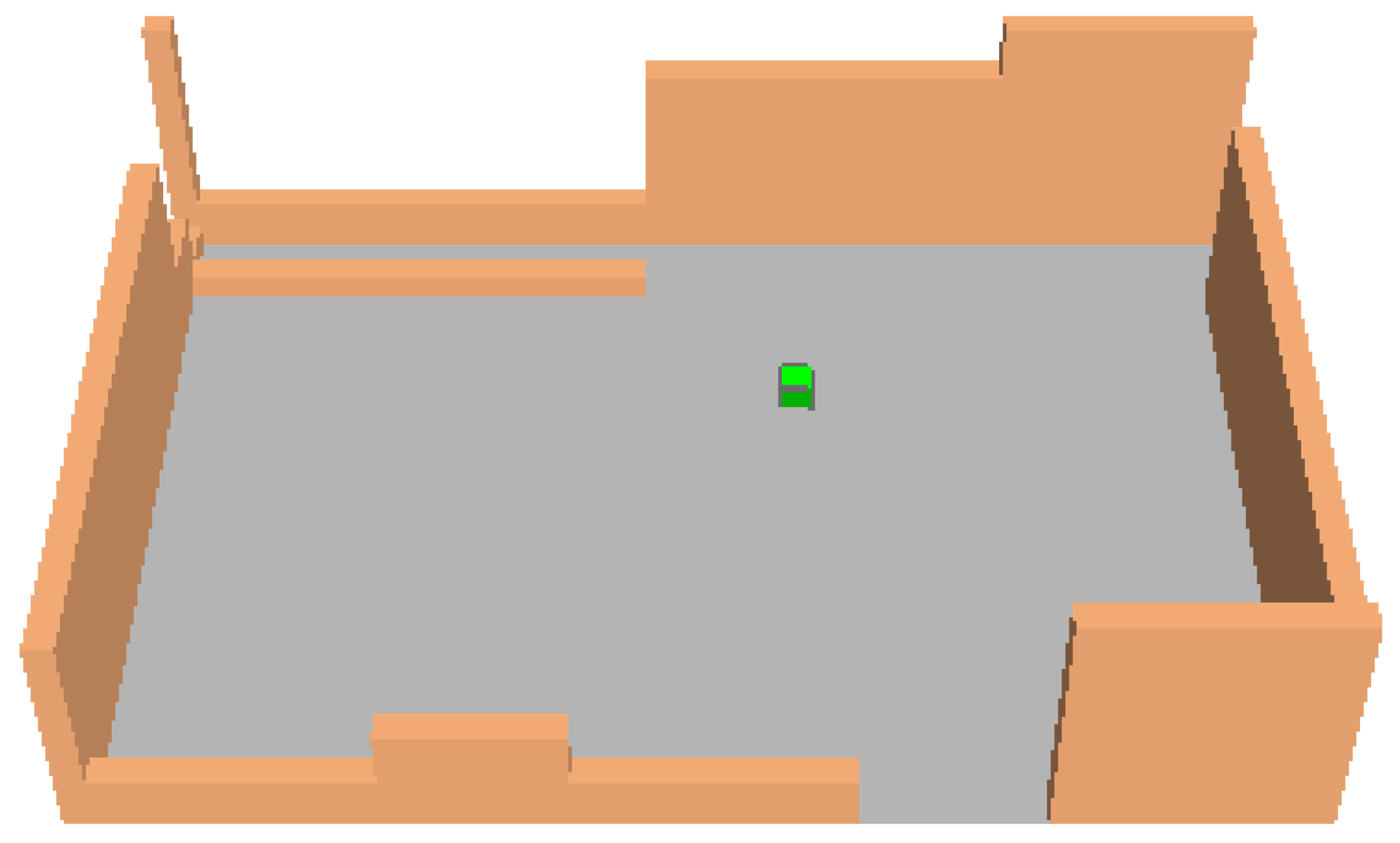
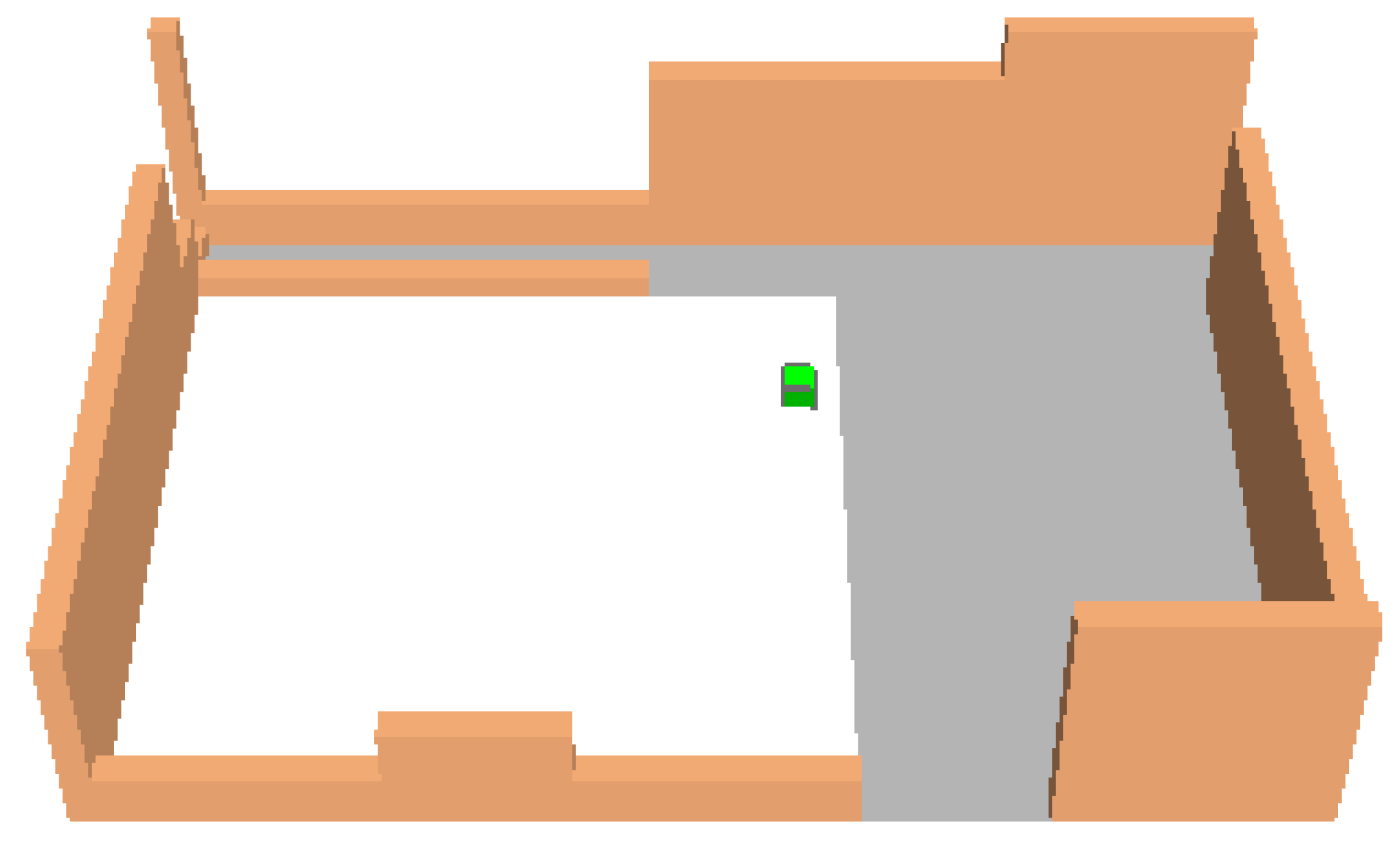

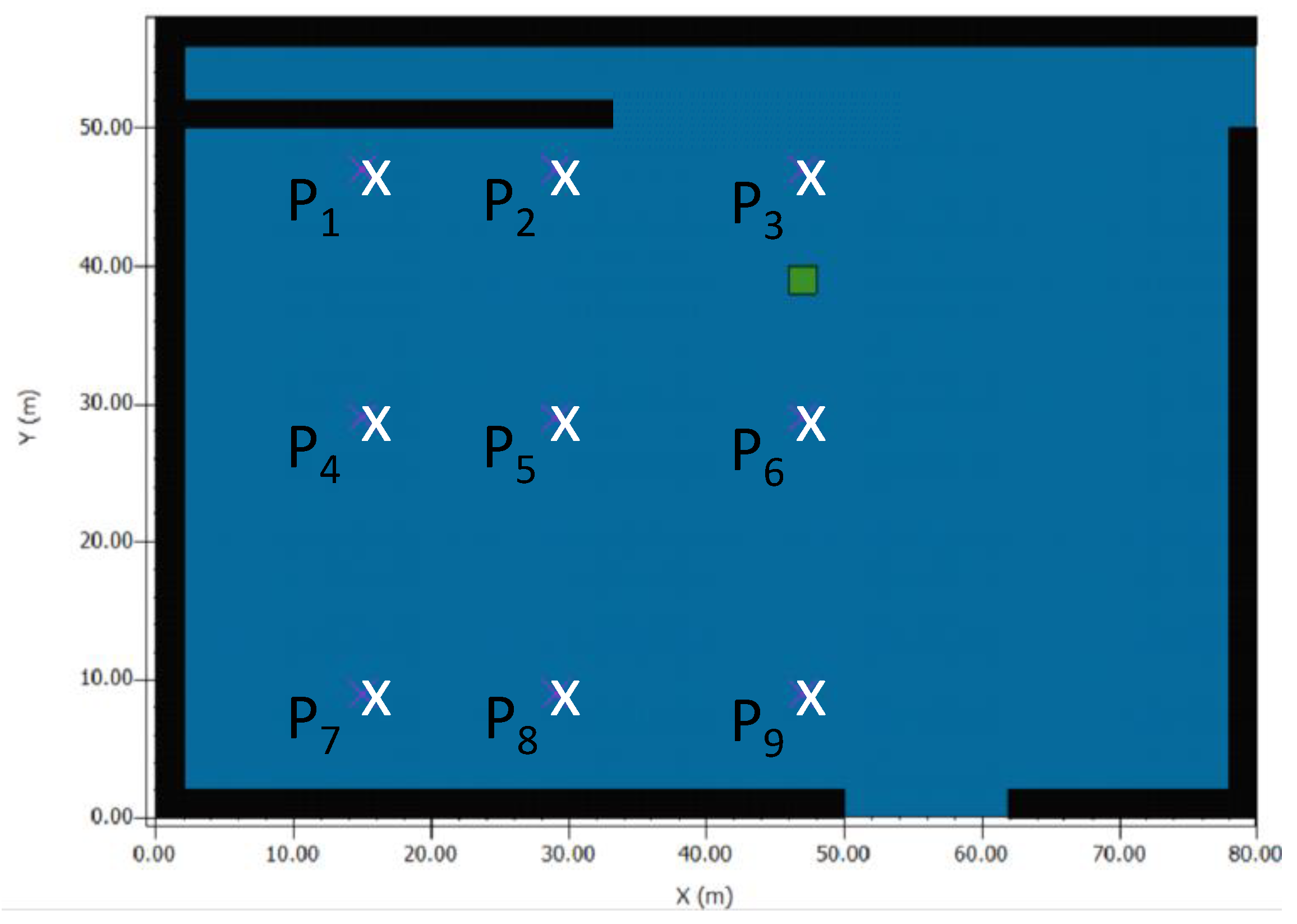


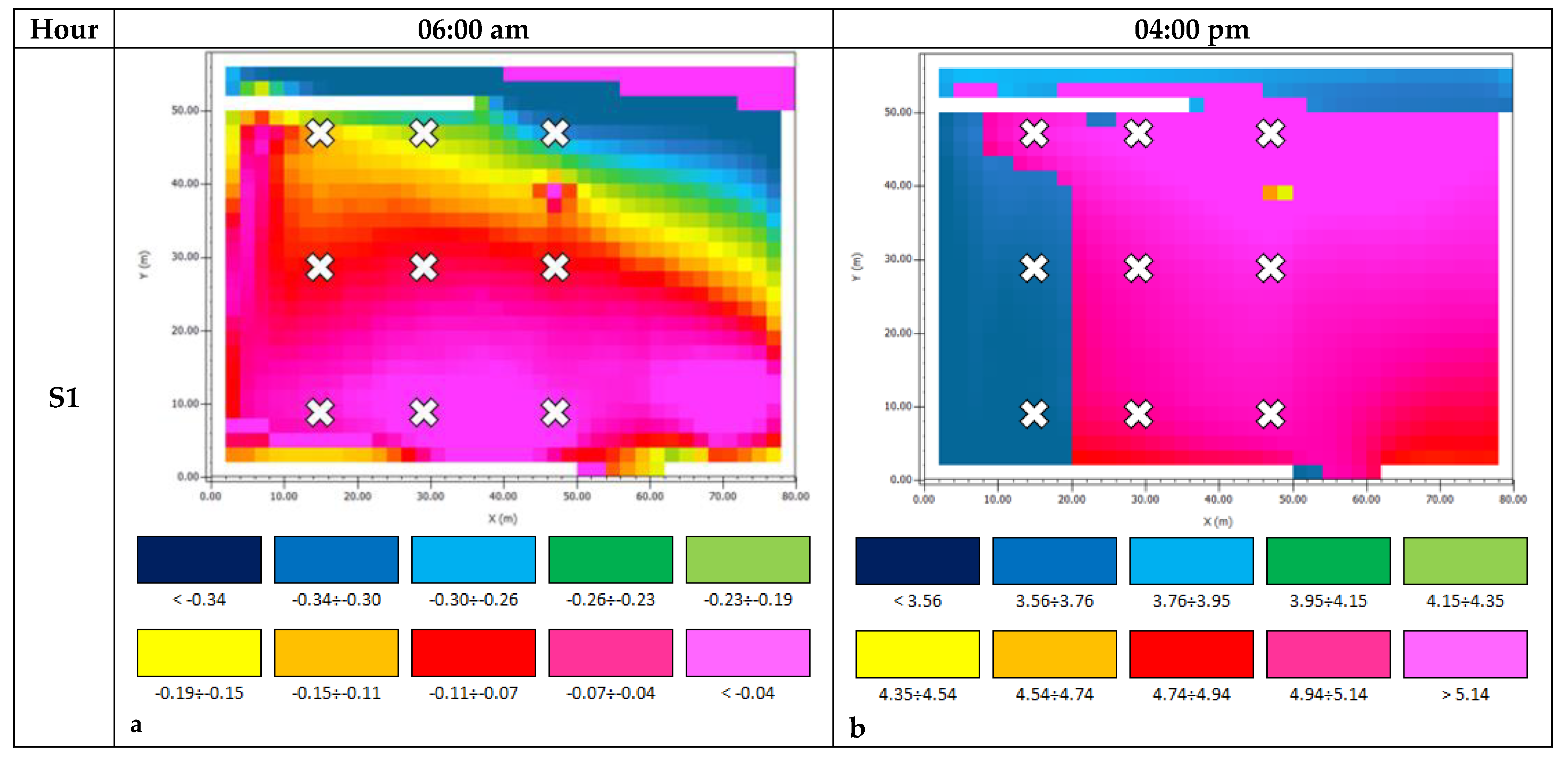

| Material | Albedo | Emissivity |
|---|---|---|
| Granite | 0.50 | 0.96 |
| Limestone | 0.70 | 0.93 |
| Marble | 0.80 | 0.95 |
| Basalt | 0.40 | 0.90 |
| Concrete | 0.50 | 0.85 |
| Asphalt | 0.10 | 0.93 |
| Tmax (°C) | Tmin (°C) | Wind Speed (m/s) | Wind Direction (°) |
|---|---|---|---|
| 35 | 21 | 3.0 | West |
| Scenario | Surveyed Point | AT (°C) | PMV | AT (°C) | PMV |
|---|---|---|---|---|---|
| 06:00 a.m. | 04:00 p.m. | ||||
| S1 | P1 | 22.78 | −0.19 | 34.57 | 5.24 |
| P2 | 22.75 | −0.25 | 34.92 | 5.33 | |
| P3 | 22.51 | −0.33 | 35.75 | 5.53 | |
| P4 | 23.51 | −0.08 | 33.42 | 3.61 | |
| P5 | 23.52 | −0.06 | 34.14 | 5.20 | |
| P6 | 23.41 | −0.07 | 34.55 | 5.29 | |
| P7 | 23.88 | −0.02 | 33.31 | 3.56 | |
| P8 | 23.91 | 0.01 | 33.87 | 5.12 | |
| P9 | 23.80 | 0.00 | 34.15 | 5.19 | |
| S2 | P1 | 22.84 | −0.17 | 34.12 | 5.19 |
| P2 | 22.81 | −0.22 | 34.42 | 5.27 | |
| P3 | 22.58 | −0.30 | 35.22 | 5.46 | |
| P4 | 23.58 | −0.05 | 33.03 | 3.66 | |
| P5 | 23.59 | −0.03 | 33.58 | 5.12 | |
| P6 | 23.50 | −0.04 | 33.91 | 5.19 | |
| P7 | 23.96 | 0.01 | 32.86 | 3.59 | |
| P8 | 24.00 | 0.04 | 33.26 | 5.03 | |
| P9 | 23.90 | 0.03 | 33.55 | 5.11 | |
| S3 | P1 | 22.76 | −0.20 | 34.18 | 5.21 |
| P2 | 22.72 | −0.25 | 34.49 | 5.29 | |
| P3 | 22.47 | −0.34 | 35.30 | 5.49 | |
| P4 | 23.48 | −0.09 | 33.09 | 3.68 | |
| P5 | 23.48 | −0.07 | 33.65 | 5.14 | |
| P6 | 23.37 | −0.08 | 34.00 | 5.22 | |
| P7 | 23.83 | −0.03 | 32.93 | 3.62 | |
| P8 | 23.87 | 0.01 | 33.35 | 5.06 | |
| P9 | 23.76 | −0.01 | 33.63 | 5.13 | |
| Scenario | Minimum AT (°C) | Maximum AT (°C) | Minimum AT (°C) | Maximum AT (°C) |
|---|---|---|---|---|
| 06:00 a.m. | 04:00 p.m. | |||
| S1 | 22.51 | 23.91 | 33.31 | 35.75 |
| S2 | 22.58 | 24.00 | 32.86 | 35.22 |
| S3 | 22.47 | 23.87 | 32.93 | 35.30 |
| Scenario | Minimum PMV | Maximum PMV | Minimum PMV | Maximum PMV |
|---|---|---|---|---|
| 06:00 a.m. | 04:00 p.m. | |||
| S1 | −0.33 | 0.01 | 3.56 | 5.53 |
| S2 | −0.30 | 0.04 | 3.59 | 5.46 |
| S3 | −0.34 | 0.01 | 3.62 | 5.49 |
Publisher’s Note: MDPI stays neutral with regard to jurisdictional claims in published maps and institutional affiliations. |
© 2021 by the authors. Licensee MDPI, Basel, Switzerland. This article is an open access article distributed under the terms and conditions of the Creative Commons Attribution (CC BY) license (https://creativecommons.org/licenses/by/4.0/).
Share and Cite
Moretti, L.; Cantisani, G.; Carpiceci, M.; D’Andrea, A.; Del Serrone, G.; Di Mascio, P.; Loprencipe, G. Effect of Sampietrini Pavers on Urban Heat Islands. Int. J. Environ. Res. Public Health 2021, 18, 13108. https://doi.org/10.3390/ijerph182413108
Moretti L, Cantisani G, Carpiceci M, D’Andrea A, Del Serrone G, Di Mascio P, Loprencipe G. Effect of Sampietrini Pavers on Urban Heat Islands. International Journal of Environmental Research and Public Health. 2021; 18(24):13108. https://doi.org/10.3390/ijerph182413108
Chicago/Turabian StyleMoretti, Laura, Giuseppe Cantisani, Marco Carpiceci, Antonio D’Andrea, Giulia Del Serrone, Paola Di Mascio, and Giuseppe Loprencipe. 2021. "Effect of Sampietrini Pavers on Urban Heat Islands" International Journal of Environmental Research and Public Health 18, no. 24: 13108. https://doi.org/10.3390/ijerph182413108
APA StyleMoretti, L., Cantisani, G., Carpiceci, M., D’Andrea, A., Del Serrone, G., Di Mascio, P., & Loprencipe, G. (2021). Effect of Sampietrini Pavers on Urban Heat Islands. International Journal of Environmental Research and Public Health, 18(24), 13108. https://doi.org/10.3390/ijerph182413108











